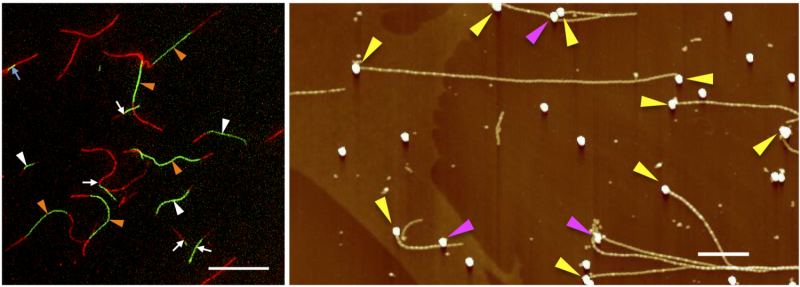A versatile method to pattern functionalized nanowires

A team of researchers from Hokkaido University has developed a versatile method to pattern the structure of "nanowires," providing a new tool for the development of novel nanodevices.
There has been considerable interest worldwide in the patterning of functionalized nanowires—which excel both in semiconductivity and as catalyzers—due to the potential application of such materials in nanodevice construction. Establishing a versatile approach to make functionalized nanowires, with a particular need to controlling spatial patterning, has been seen as essential.
The team, led by Professor Kazuyasu Sakaguchi of the Faculty of Science's Department of Chemistry, had previously developed an effective method, named structure-controllable amyloid peptides (SCAPs), to control self-assembly of amyloid peptides, which are the building blocks of nanowires and also known as the causative molecule for Alzheimer's disease. In the latest research, the team combined the SCAPs with templated fibril growth—a distinctive quality of amyloid peptides—and succeeded in the formation of nanowires with tandem domain structures or a single nanowire extending from a specific starting point.
To create the tandem structure, the SCAPs method was used to make initial amyloid fibrils—marked by green fluorescence—which were used as a template, and to allow another type of amyloid peptide—marked by red fluorescence—extend from the starting fibrils. Analysis showed a 67% tandem yield, three times higher than the efficiency yield of previous studies. Moreover, a few geometrical patterns could be discerned in the tandem structures, the proportion of which could be controlled by adjusting the peptide mix ratio.
Furthermore, by attaching template fibrils to gold nanoparticles placed on substrate surface through molecular recognition, then allowing new fibrils to extend from the template, the researchers succeeded in forming a single nanowire in a specific location. Achieving this kind of advanced pattern control is a world-first.
This method is applicable to the self-assembly of nanowires for nanoelectrodes created by lithography. "It could also be used to prepare a wide variety of fibril patterns and hence open up new avenues for the development of novel self-assembled nanodevices," Professor Sakaguchi said.
More information: Hiroki Sakai et al. Patterning nanofibrils through the templated growth of multiple modified amyloid peptides, Scientific Reports (2016). DOI: 10.1038/srep31993
Journal information: Scientific Reports
Provided by Hokkaido University



















